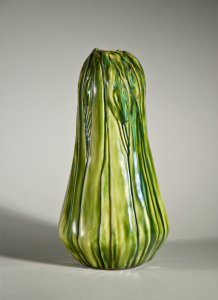By 1904, when Tiffany (1848–1933) publicly debuted his pottery at the Louisiana Purchase Exhibition in St. Louis, ceramics were part of every major decorative arts company’s product line. Only two thousand pieces are thought to have been produced, and even fewer survive today. The Museum’s holdings—the largest public collection of Tiffany pottery anywhere—extend from early production to late.
Tiffany distinguished his pottery with complex glazing and forms based on a wide variety of sources. Motifs from the natural world predominate in Tiffany’s pottery. Seedpods, artichokes, water lilies and more have been reproduced in clay with astonishing realism. Most Tiffany pottery was made in limited castings from molds and then finished by hand. Each therefore was unique.
Three crocus vases on view, two of which are recent acquisitions, articulate the artful variations possible among standardized forms. The new pieces, on display for the first time, are marked A-Coll for “artist’s collection.” Tiffany chose them for his personal collection as models of aesthetic and technical success. Ultimately, Tiffany’s pottery was defined by the artist’s never-ending experimentation. This presentation of selections from the Museum’s collection celebrates the design genius’s achievements with the ceramic medium that proved irresistible in his pursuit of beauty.



